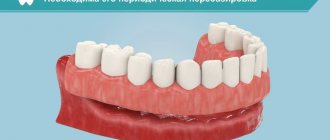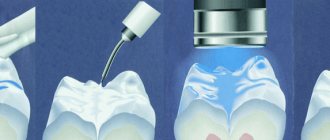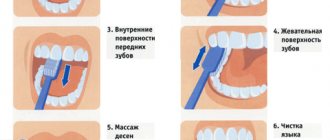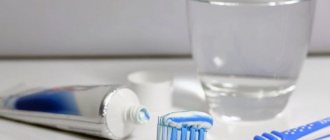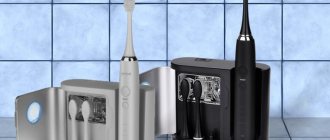249
Even brushing your teeth twice a day does not guarantee complete removal of plaque.
A thin, almost invisible film containing food debris, saliva components and many microorganisms can be located in the interdental space and other secluded places, remaining inaccessible to the brush.
To ensure that plaque is removed, it must first be visualized. This is exactly what plaque indicators offered by many companies producing oral care products serve.
General overview
Plaque indicators are special dental care products that make plaque visible. They are available in the form of tablets and solutions, and contain various substances that help visualize food debris and microbes remaining on the enamel.
Research has established that 2-3 days after the formation of fresh plaque, acid-forming microorganisms already appear in it and begin to destroy the enamel. Therefore, to prevent caries, it is necessary to brush your teeth at least once every 2 days so as to completely remove plaque from them.
The indicators include main and auxiliary components. The former adsorb and “reveal” the substances contained in plaque in a bright color, thereby informing the user where, in what quantity, and what nature (fresh or old) the dental film is preserved. Auxiliary components increase the convenience and comfort of using the product.
The main components of plaque indicators are:
- dyes (represented by red and blue food colors, erythrosine, iodeosine);
- substances with antimicrobial effects (potassium sorbate, sodium benzoate);
- adsorbents.
Auxiliary ingredients: flavorings (essential oils), sweeteners (xylitol, saccharin), glycerin, water, etc.
A few words should be said about erythrosine, which is considered an undesirable element in plaque indicators due to the release of iodine, which can adversely affect the thyroid gland.
Because of this, the use of erythrosine as a food additive is prohibited in Russia. In other countries there is no such ban. Most likely, fears of erythrosine in the indicator are exaggerated. But each user must decide for himself whether to use an indicator containing erythrosine or buy those that do not contain it. By the way, there are a sufficient number of them on offer.
The mechanism of action of the indicator is that, when applied to dental plaque, it reveals it in a bright color, while plaque-free enamel, if stained, is not so intense.
This allows you to see places where plaque remains and spend more time on them when brushing your teeth. A very useful property of indicators is the ability to visualize fresh and old plaque in different color shades.
Let's figure out together how plaque is removed in dentistry, and whether it is possible to get rid of it at home.
Come here if you are interested in objective reviews about dental enamel implantation.
At this address https://www.vash-dentist.ru/lechenie/zubyi/emal/chem-opasna-eroziya.html we will talk about the reasons for the development of erosion of tooth enamel and methods of its treatment.
Mechanism of action of indicators
You can check how clean your teeth are by using special means to indicate plaque on your teeth. Today, there are many similar pharmacological preparations in the form of tablets, sprays and liquids that detect the presence of plaque. The most popular is the tablet form, since tablets have a lower cost and high ease of use.
The principle of action of plaque indicators is as follows: special food dyes, which are included in such products, color the sticky film of the oral cavity, which is plaque, in a bright color. This action allows you to visually identify areas of the dentition that need to be given more attention during the cleaning process.
Main varieties
Plaque indicators are available in three forms:
- pills;
- solutions;
- concentrates.
Before use, the latter must be dissolved in water and then used as a regular solution.
Indicators are used by dentists in clinics and by users at home to ensure guaranteed plaque removal.
Experts use indicators for the following purposes:
- demonstrating to the patient the true situation with his oral hygiene;
- teaching them proper oral care;
- monitoring the results of professional cleaning.
The use of indicators by users at home allows them to see the hygienic state of their teeth and, if necessary, clean them more thoroughly.
Reference . It has not yet been determined exactly how many times a day you need to brush your teeth to keep them in perfect condition. There is even an opinion that this should be done before and after each meal.
However, in practice this is difficult to implement. Therefore, most experts believe that the best option is to brush your teeth twice in the morning and in the evening. Moreover, the quality of cleanings can be considered a more important parameter than their quantity.
If you completely remove plaque at least once a day, this will eliminate the impact of acids produced by microorganisms on the enamel - taking into account the fact that they need at least two days to begin to show their carious activity.
Dosages and home use
It is worth noting that this group of products is widely used not only in dental offices: anyone can buy a plaque indicator to independently assess the condition of the oral cavity. Most often, this is required to determine the effectiveness of the measures taken - professional teeth cleaning or self-cleaning, assessing the correctness of the cleaning technique using a brush and dental floss.
Indicators are produced in various volumes. A package of tablets can contain from 6 to 250 pieces, depending on the needs of the buyer. A bottle of solution contains from 10 to 500 ml; some manufacturers produce the liquid product in packs of 10 bottles.
You can buy a plaque indicator on your teeth in the online dental store Dentleman.ru. Nice prices and special offers are a great opportunity to save a lot. The availability of a wide range of options for receiving an order when placing a delivery is ensured through well-thought-out logistics. High-quality products from branded manufacturers can be paid for using any convenient method - we value our customers, take into account their wishes and offer several forms of payment.
Usage algorithm
The essence of using a plaque indicator is to apply it to the surface of the teeth and see which areas turn into what color. Many indicator products have a 2-shade indication: fresh plaque is painted one color, old plaque is painted in another. Both need to be removed.
The use of indicators in the form of tablets and solution differs somewhat.
The tablets are chewed and the mixture is spread with the tongue over the surface of the teeth. After which they pause for several tens of seconds, rinse their mouth with water, and contemplate the multi-colored picture, assessing the amount and location of plaque. Then brush your teeth until there are no stained areas left.
If they still do not disappear, it means that there is old plaque, or the cleaning was not carried out effectively enough. In the first case, it is recommended to do professional cleaning; in the second case, repeat it more thoroughly. You may have to purchase another, more abrasive paste.
The solution is applied with a brush, tongue dipped in indicator liquid (a few milligrams of the solution are poured onto it) or by simply rinsing the mouth. After this, repeat the same steps as when using tablets: rinse your mouth and brush your teeth until the stained areas are completely removed.
The main precaution when using indicators is to be careful not to accidentally ingest them. This does not threaten anything particularly terrible, but it is better not to present such a “surprise” to your stomach.
Plaque indicators
In dental practice, 0.75% and 6% solutions of basic fuchsin, 4-5% alcohol solution of erythrosine, erythrosine in tablets (6-10 mg each), Schiller-Pisarev solution, 2% aqueous solution of methylene are used as diagnostic stains for dental plaque. blue.
Fuchsin (Fuchsini) is a basic solution of fuchsin. Colors dental plaque crimson. The drug is used for rinsing.
Rp.: Fuchsini bas. 1.5 Spiritus aethylici 75% 25 ml DS 15 drops per 1/2 glass of water (for rinsing the mouth for 20 s)
Erythrosin is a red dye of low toxicity. Contains iodine. Available in the form of a 4-5% alcohol solution and tablets (Mentadent C-Plague, Oga] In Einfarb Plagueindikator, Plague-Farbetabletten, etc.).
Rp.: Sol. Erythrosini 5% 15 ml DS Apply with a cotton swab to the surface of the teeth
Rp.: Tab. Erythrosini 0.006 N. 30 DS Chew 1 tablet for 1 minute
Fluorescein is a plaque dye that does not contain iodine, so it can be used in patients who are sensitized to iodine. Fluorescein-stained plaque is visible only under ultraviolet light. Available under the names “Plak-Lite” (“Blendax”), “Fluorescein” 0.75%.
Schiller-Pisarev solution stains dental plaque yellow-brown. The drug is applied to the surface of the teeth using a cotton swab.
Rp.: lodi 1.0 Kalii iodidi 2.0 Aq. destill. 40 ml MDS Schiller-Pisarev solution. Apply with a cotton swab to the surface of the teeth
Methylene blue (Methylenum coeruleum) is used to identify dental plaque: a 1-2% aqueous solution of methylene blue is applied to the surface of the teeth using a cotton swab.
Rp.: Methyleni coerulei 2.0 Aq. dcstiil. 100 ml MDS To lubricate the surface of teeth
Lugol's solution: Composition: KI - 2.0 g I crystalline - 1.0 g distilled water - 17 ml Method and mechanism are the same as in the previous dye
Disclosing Solution (60ml) — Directions for use: Prepare a solution: 10 drops of indicator per 30 ml of water. Rinse your mouth. Do not swallow! Colored areas indicate the presence of bacterial plaque. Carry out additional cleaning of problem areas.
Caterol – Indicator of dental plaque (dental plaque), liquid for removing plaque and cleaning teeth.
KATEROL is an indicator of dental plaque (dental plaque), a drug for removing dental plaque and cleaning teeth.
A bottle containing 14 ml of the drug.
Ingredients: hydrochloric acid, iodine, acetone, excipients. Properties: Caterol softens calculus deposits and destroys supragingival plaque, facilitating subsequent mechanical removal using instruments.
Caterol also helps detect plaque and tartar by turning it yellow.
Contraindications: allergy to iodine or its derivatives.
Instructions for use.
- Using a thick cotton ball soaked in Caterol and wrung out well, carefully rub the tartar deposits, trying to avoid contact with the gum as much as possible.
- Wait a few seconds for the stone to become soft before mechanical.
Curaprox tablets - Turns old plaque blue and new plaque red. Ideal for home use. Each tablet is individually packaged.
Curadent Plaque Indicating Liquid Old plaque turns blue, and fresh plaque turns red. (60 ml - 1,615 rubles).
Plaque Agent ( Docdont) - mouth rinse to detect plaque (500 ml -400 rubles)
The mouthwash is suitable for both adults and children.
The mouthwash does not contain erythrosine, so it is successfully used by both adults and children. This method of identifying plaque is especially suitable for children, since they cannot always assess whether they have carried out the process of cleaning their teeth correctly. And if you rinse your mouth with this solution before doing this, you can monitor the quality of cleaning.
Recommendations: Use by children under 12 years of age should be under adult supervision. Pour 10 ml of mouthwash into a measuring cup, rinse your mouth for 30 seconds, and spit it out. Clean blue areas thoroughly with a toothbrush and toothpaste.
Plaquetest tablets for detecting dental plaque
Plaquetest tablets for detecting dental plaque. Old dental deposits are painted dark blue, new ones – purple-red.
To carry out the test: place the tablet on the tongue (half is enough for children), chew and spread over the entire dentition with the tongue. Spit it out - it's done! The paint is easily removed with regular tooth brushing.
Ingredients: lactose, magnesium stearate, silicon dioxide, meadow mint, CI 42090 (food coloring), CI 45410 (food coloring).
Criterias of choice
Before buying an indicator, it is advisable to find out who its manufacturer is and what components it contains. It is recommended to purchase a well-known brand. In this case, you can not expect unforeseen “surprises”, in particular, bright and long-lasting staining of the oral mucosa. It is desirable that the latter is not painted at all, or at least that the paint disappears after a short period of time.
Of particular importance is the shape of the indicator and, of course, the price. Adults can use both tablets and solution with equal success. For children, a solution that has a pleasant taste and smell is desirable. It is important that using the indicator does not cause negative feelings in them.
As for the price, it is desirable, of course, that it be less, but not at the expense of quality. In general, if you are purchasing an indicator of a particular brand for the first time, it is better to purchase a package with a small amount - 10 or 20 ml, or 6-10 tablets. And in the future, if the product shows itself well, you can buy larger quantities.
Methods for detecting dental plaque
Quantitative characteristics are based on the clinical detection of certain types of dental plaque, determination of their localization in relation to the tooth crown, the area they occupy, and less often - volume and mass. To detect dental plaque, use: inspection, inspection after drying the surface of the teeth with an air jet, probing, inspection after staining (Table 5.7)
Drying allows you to eliminate the masking shine of the oral fluid, after which you can distinguish the equally colored matte surface of dental plaque and the shiny surface of the enamel.
Probing hard plaque and soft plaque is essentially scraping away the deposits with the tip of the probe. Tactile sensations obtained during probing are needed to detect tartar: calculus is defined as an uneven, less dense surface than enamel, which may end in a “break.”
Staining is necessary to detect dental plaque. Plaque is visible to an experienced eye even without staining, but this procedure helps, on the one hand, to more accurately take into account the amount of deposits and, on the other hand, to more convincingly discuss with the patient the level of oral hygiene and control the dynamics of hygienic skills.
Most of the dyes used react nonspecifically with any organic substrate: plaque matrix, bacterial cells, food debris, salivary components, oral mucosa, red border of the lips, skin, etc. The exception is sodium fluorescein, which becomes visible (yellow) only in those areas where the dye has been adsorbed to form a significant layer (at 200-540 nm), i.e. in areas with dental plaque and only under ultraviolet light through special filters.
There are red (erythrosine, fuchsin), blue (methylene blue, gentian violet), brown (Bismarck brown, Schiller-Pisarev solution) dyes and mixtures thereof. Interesting are the “double” indicators, combining erythrosine and green malachite, which, depending on the age and pH of the plaque, colors it either red (fresh plaque) or blue (old plaque).
From an aesthetic and methodological point of view, it is important to distinguish between persistent and unstable dyes. Unstable dyes include Lugol's solution and Schiller-Pisarev solution, containing iodine compounds: since they are volatile, the coloring disappears after 10-20 minutes. This is convenient in cases where only diagnostics of dental plaque and patient motivation are expected, but not hygienic procedures. For professional oral hygiene or for training in individual teeth cleaning, it is more advisable to use persistent dyes (all of the above, except iodine-containing ones), which remain on the surface of dirty teeth for hours, but, naturally, disappear when they are cleansed.
Professional oral hygiene is a set of measures aimed at removing dental plaque and preventing the occurrence and progression of dental diseases. This procedure is performed by a dental hygienist. This is an integral part of the treatment of all major dental diseases. In addition to brushing teeth, the hygienist’s task includes teaching proper oral care and selecting individual hygiene products.
Professional oral hygiene includes removing soft dental plaque and tartar from all tooth surfaces, polishing teeth and fillings, teaching patients the rational use of oral care products and methods and monitoring its hygienic condition. By completely removing dental plaque, you can prevent the development of dental caries and gum disease. However, dental plaque can be completely removed using special means, devices and tools, and patients themselves must strictly follow the doctor’s instructions for individual oral hygiene. Every patient should be convinced that careful and proper oral care is the most important preventive and auxiliary therapeutic procedure. Thus, it is the dentist's job to educate patients to maintain a level of oral hygiene that is sufficient to prevent dental caries and periodontal disease. The number of visits for professional oral hygiene depends on the individual characteristics of the sick or healthy person. Features of tartar removal. Removal of supragingival and subgingival tartar must be carried out very carefully, since the remaining tartar injures the gums with its sharp edges during subsequent brushing of the teeth, and also contributes to faster deposition of new tartar. The most common mechanical method of removing tartar using special tools: excavators, hooks, etc.
When removing tartar, the following rules must be observed: 1) all instruments must be sterile; 2) before removing tartar, antiseptic treatment of the surgical field should be carried out; 3) the teeth being treated must be isolated from saliva; 4) the hand holding the instrument must be fixed on the patient’s chin or adjacent teeth; 5) mobile teeth must be fixed with the fingers of the left hand; 6) the main movements - lever-like and scraping - should be smooth, non-traumatic; 7) after removing the stone, the teeth must be polished; the instrument must be suitable in shape and size and match the curves of the tooth surface.
2) before removing tartar, antiseptic treatment of the surgical field should be carried out; 3) the teeth being treated must be isolated from saliva; 4) the hand holding the instrument must be fixed on the patient’s chin or adjacent teeth; 5) mobile teeth must be fixed with the fingers of the left hand; 6) the main movements - lever-like and scraping - should be smooth, non-traumatic; 7) after removing the stone, the teeth must be polished; the instrument must be suitable in shape and size and match the curves of the tooth surface.
The removal of subgingival calculus must be monitored using a probe. When using ultrasonic devices to remove dental plaque, you should be guided by three basic rules: 1) do not place the tip of the instrument perpendicular to the tooth surface; 2) do not put any pressure on the tooth; 3) do not use the device without water cooling.
Popular manufacturers
The most famous plaque indicators supplying the Russian market are the Swiss Parodent and Curaprox, the German Hager&Werken, and the Italian PresiDent. Among the Russian ones are “VladMiVa” and “StomaDent”.
The characteristics of their products are given in the table below.
| Brand, country | Release form | Peculiarities | Price in rubles, equipment |
| Miradent mira, Miradent brand, Germany | Solution | Without erythrosine | 1500 (60 ml) |
| Mira-2-Ton, Miradent brand, Germany | Solution Tablets | Without erythrosine, has a pleasant taste, suitable for children | 500 (10 ml) 370 (10 tablets) |
| Plaque Agent, Miradent brand, Germany | Solution | Without erythrosine, does not stain mucous membranes, has a pleasant taste, suitable for children | 800 (500 ml) |
| Curaprox, Switzerland | Tablets Solution | two-tone display | 617 (12 tablets) 3,900 (60 ml) |
| President of Plaque Test (Italy); | Solution | 290 (10 ml) | |
| StomaDent (Dinal brand, Russia) | Pills | Children need ½ tablet | 140 (10 tablets) |
| Color Test No. 3, VladMiVa, Russia | Solution | Does not change the color of the mucous membrane | 105 (20 ml) |
Why do cracks appear on tooth enamel and what to do in such a situation.
This publication contains all the most important things about dental tissue necrosis.
Here https://www.vash-dentist.ru/lechenie/zubyi/tipyi-rezorbtsii-kornya.html read: in what cases is tooth root resorption normal, and when is specialist help required?
Benefits of tablets
- The tablets have a dry medium, which means that they do not require a large amount of preservatives: dry cosmetic products deteriorate more slowly.
- The dry texture of the tablets is also safer in terms of the growth of bacteria and fungi.
- The dry form of release allows you to vary different tastes and colors of the product. Not all fragrances “survive” in a humid environment.
- Lightweight and compact compared to toothpaste tubes, making them a good travel solution.
- 100% recycling
. There is no need to pollute the environment with plastic tubes, the tablets are only packed in a cardboard box, which is degradable and environmentally friendly waste. - Tablets can be a good ingredient for home whitening formulations. It is enough to dissolve it in water with soda, and you will get a bleaching composition.
- You can take the tablets with you to work and even on a date. When you don’t have a toothbrush, you can simply soak the tablet in your mouth with saliva, chew it a little and spit it out. The result is fresh breath and clean teeth enamel.
Medicines for children
The selection of an indicator for children is important from the point of view of developing the habit of brushing their teeth correctly. Therefore, its use should be comfortable, and not only not cause protest, but even give him pleasure due to the presence of bright colors and a pleasant taste, reminiscent of chewing gum.
As for the form, the solution is more suitable for children than tablets. In addition, when choosing a product for them, you should pay attention to their composition. Indicators for children should be free of potent substances that stain the mucous membrane and erythrosine.
These conditions are met by the Mira-2-Ton brand in the form of a solution - a product of Hager&Werken - and the Plaque Agent drug from the same manufacturer. These solutions do not contain erythrosine and have sweeteners and flavoring additives to make them tasty. Their characteristics and prices are shown in the table above.
It is advisable to start using plaque indicators at a very early age. The sooner your child develops the habit of brushing their teeth properly, the better.
The video provides additional information on the topic of the article.
How to use them correctly?
First, the usual procedure for cleaning teeth is carried out. After this, a special coloring tablet is chewed (they are sold in pharmacies and medical equipment stores), and the oral cavity then needs to be rinsed with water.
In places where there is still plaque, the enamel is painted a certain color (it is indicated in the instructions). What can be removed from the surface with the tongue is colored saliva, but what cannot be removed is plaque that is not removed during cleaning. These areas should be thoroughly cleaned after the indication.
To carry out this procedure, a small oral mirror may be useful, with which you can examine the inside of the teeth. In addition to practical benefits for adults, indicator tablets also have pedagogical benefits for children - with their help, by showing by example, children can be taught to brush their teeth correctly, pointing out those areas that are subject to the most thorough treatment.
Reviews
Some parents believe that taking care of their child’s teeth should begin after their permanent ones erupt. What's the point of caring for milk jugs that will fall out anyway in a few years? This is a serious mistake.
The condition of temporary teeth affects permanent teeth - their eruption and intactness. It is very important for the dental system that temporary teeth fall out healthy and exactly at the right time. And these conditions cannot be ensured without proper care.
If you use plaque indicators in your family, tell us with what effect, how do you manage to get children to use them? The comment form is at the bottom of this page.
If you find an error, please select a piece of text and press Ctrl+Enter.
Tags Tartar
Did you like the article? stay tuned
Previous article
Types of tooth root resorption and a modern approach to eliminating the problem
Next article
Review of the unique combined orthodontic apparatus Khurgina
